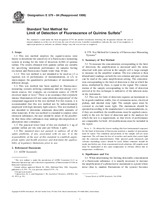We need your consent to use the individual data so that you can see information about your interests, among other things. Click "OK" to give your consent.
ASTM E579-84(1998)
Standard Test Method for Limit of Detection of Fluorescence of Quinine Sulfate
STANDARD published on 10.10.1998
The information about the standard:
Designation standards: ASTM E579-84(1998)
Note: WITHDRAWN
Publication date standards: 10.10.1998
SKU: NS-47274
The number of pages: 3
Approximate weight : 9 g (0.02 lbs)
Country: American technical standard
Category: Technical standards ASTM
Annotation of standard text ASTM E579-84(1998) :
Keywords:
Fluorescence, Instrumental measurement-spectrochemical, Minimum detectable concentration (MDC), Performance-laboratory instrumentation, Precision-instrumentation, Quinine sulfate, Sensitivity criterion/response, Signal-to-noise ratio, Spectrochemical analysis, Spectrophotometry-fluorescence, Spectroscopy-fluorescence, limit of detection of fluorescence of quinine sulfate, test, ICS Number Code 71.080.30 (Organic nitrogen compounds)
Additional information
| 1. Scope | ||
|
1.1 This test method employs the signal-to-noise ratio theory to determine the sensitivity of a fluorescence measuring system in testing for the limit of detection (LOD) of quinine sulfate. The results obtained with quinine sulfate are suitable for specifying instrument performance on samples having excitation and fluorescence bands wider than 10 nm. 1.1.1 This test method is not intended to be used as (1) a rigorous test of performance of instrumentation, or (2), to intercompare the quantitative performance of instruments of different design. 1.2 This test method has been applied to fluorescence-measuring systems utilizing continuous and low-energy excitation sources (for example, an excitation source of 150-W electrical input or less). There is no assurance that extremely intense illumination will not cause photodecomposition of the compound suggested in this test method. For this reason, it is recommended that this test method not be indiscriminately employed with high intensity light sources. This test method is not intended to determine minimum detectable amounts of other materials. If this test method is extended to employ other chemical substances, the user should be aware of the possibility that these other substances may undergo decomposition or adsorption onto containers. 1.3 The practical lower limit of this test method is 1 ng of quinine sulfate per mL (one part per billion; 1 ppb). 1.4 This standard does not purport to address all of the safety problems, if any, associated with its use. It is the responsibility of the user of this standard to establish appropriate safety and health practices and determine the applicability of regulatory limitations prior to use. |
||
| 2. Referenced Documents | ||
|
We recommend:
Updating of laws
Do you want to be sure about the validity of used regulations?
We offer you a solution so that you could use valid and updated legislative regulations.
Would you like to get more information? Look at this page.




 Cookies
Cookies
